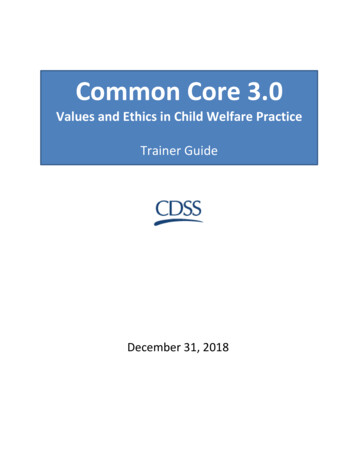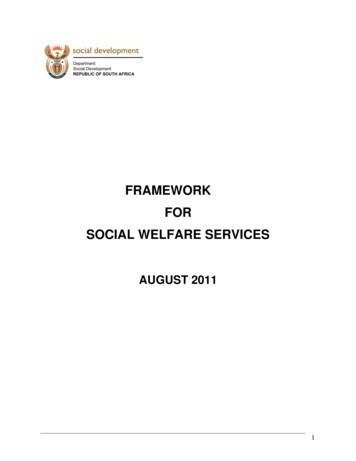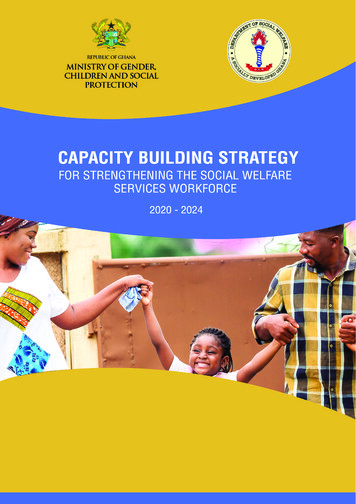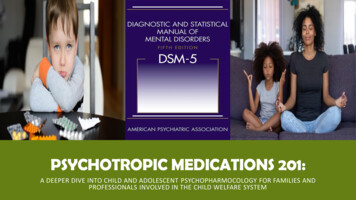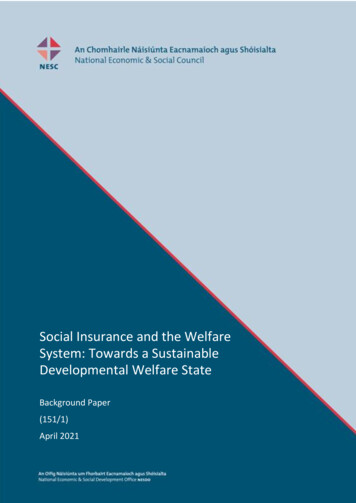
Transcription
1Social Insurance and the WelfareSystem: Towards a SustainableDevelopmental Welfare StateBackground Paper(151/1)April 2021
2
1Social Insurance and the Welfare System:Towards a Sustainable DevelopmentalWelfare StateBackground Paper(151/1)Dr Helen JohnstonDr Anne-Marie McGauranApril 2021This background paper provided additional empirical and analytical material on theissues discussed in the main Council report on The Future of the Irish Social WelfareState: Participation and Protection. It was considered by the Council in September2018.A list of the full set of NESC publications is available at www.nesc.ie
2Table of ContentsChapter 1 : Introduction1.1Rationale for the work341.2Five Propositions41.3Methodology51.4Structure of the Paper5Chapter 2 : Evolution of Social Insurance: Mixed System-Mixed Messages?2.1.Evolution, Principles and Understandings2.2Origins of Social Insurance2.3Mixed system—Mixed messages?Chapter 3 : Putting the Challenges to Social Insurance in Context3.1The Emerging Challenges to Social Insurance Funding and Welfare6781012133.2The Inevitability of Change183.3Towards Identification of Reform Possibilities: The Case forConsidering Social Insurance and Social Assistance Together20Chapter 4 : Towards an Integrated System?4.1Considerations Relevant to Closer Integration4.2If Integration is a Good Idea, Which Model of Integration is Best?Chapter 5 : Further Lines of InquiryAppendix 1Bibliography242730323540Table of BoxesBox 1:Box 2:Box 3:Box 4:Box 5:Payments made through the social insurance systemRecent Social Insurance Changes for the Self-employedThe Tax WedgeThe Financial Situation of the Social Insurance FundRecent Policy Developments in Relation to Social Insurance915161926Table of TablesTable 1:Table 2:Table A1:Table A2:Selected Social Insurance and Social Assistance Rates, 2021Expenditure and Beneficiaries of main social insurance andsocial assistance schemes, 2019PRSI classes, contributor numbers and rates, and benefitswhich can be claimedSubclasses of Class A of PRSI11233738Table of FiguresFigure 1: Gini measure of income inequality in selected countries17
3:Introduction
41.1Rationale for the workNESC is undertaking this work at the request of the Department of Social Protection(DSP). The exploration of how to move towards a more sustainable and integratedsocial welfare system builds on previous NESC work on the Developmental WelfareState (NESC, 2005), supports for the long-term unemployed (NESC, 2011a), standardsin human services (NESC, 2011b, 2012a, 2012b, 2012c, 2012d, 2012e, 2012f, 2012g),and how the system engages with low work intensity households (NESC, 2018).The paper explores the emerging challenges for the social insurance fund and thewider welfare system, which align with many of the issues raised in the study of lowwork intensity households. Many of the themes identified resonate with concernsaddressed in the Developmental Welfare State (DWS) and make a case for exploringhow to move towards a sustainable development welfare state.1.2Five PropositionsThis paper advances a number of propositions:i.Further changes in the social insurance system are inevitable, given thedemographic, economic and social changes underway;ii.Although the funding pressures will become more serious, given the long-termnature of the underlying drivers, the Irish welfare system is not in crisis andcontinues to play an important economic and social role;iii.Social insurance and social assistance should not be considered as two entirelydistinct systems, but should be considered as a whole;iv.Indeed, both social insurance and social assistance should be considered as partof the wider social welfare system which, as well as income transfers, contains aservices and innovation element—as understood in the Developmental WelfareState; andv.The social welfare system interfaces with the tax system in redistributingincome and providing income supports and social services.
5These propositions have implications for how the Council should respond to theDEASP request for a NESC analysis on social insurance and welfare. This paper beginsthat exploration by discussing the idea that Ireland move towards a more integratedincome support system in which social insurance and social assistance are moreclosely aligned.1.3MethodologyThe methodology employed in preparation of this paper includes a review of relevantIrish policy documents, reference to some international responses and exploratoryinterviews with key Irish stakeholders, including personnel in the Departments ofSocial Protection, Finance, and Public Expenditure and Reform, employers’organisations, trade unions, relevant state agencies and NGOs. The interviews wereundertaken on a confidential basis with interviewees remaining anonymous. Theyhelped to inform thinking about the key concerns facing the social insurance systemand potential ways forward. As expected, there is a range of views reflecting thecomplexity of the system and the need for trade-offs and balances. One of thebenefits of NESC work in this area is constructive deliberation on future possibilities.1.4Structure of the PaperThe next section identifies the principles underpinning the social welfare system, anddiscusses the origins of social insurance. Section 3 sets out the emerging challengesto social insurance funding and welfare, concluding with the identification of somereform possibilities. These are discussed in an initial way in section 4 wherepossibilities of a more integrated system are considered. The final section identifiesfurther lines of inquiry for the Council’s work on this project.
6:Evolution of Social Insurance: MixedSystem-Mixed Messages?
72.1. Evolution, Principles and UnderstandingsIn facilitating deliberation on the future of the social insurance system, it is necessaryto jointly consider the evolution of the system, the principles associated with it andthe understandings of its purpose and nature. One reason is that somewhat differentprinciples can be enunciated with respect to various parts of the system: In considering social insurance systems, it is common to cite the ‘solidarity’principle and the ‘contributory’ principle (see further below); The 1986 Report of the Commission on Social Welfare (Department of SocialWelfare, 1986) and the 1996 review Social Insurance in Ireland (Department ofSocial Welfare, 1996) identified the key principles underlying the social welfaresystem as adequacy, redistribution, comprehensiveness, consistency andsimplicity; The Roadmap for Pensions Reform states that the principles that should guide theevolution and development of the pensions system are adequacy, sustainabilityand equity (Government of Ireland, undated). The nine principles listed differ somewhat from one another, and are sometimesin tension with each other. More importantly, like almost all principles, none ofthem has an unambiguous meaning and, therefore, each requires further factorsto be taken into account in their application in any given context. A brief sketch of the evolution of the welfare system illustrates the way in whichthis has been done and also some of the reasons why it is now time think aboutthe next phase of development. Ireland, like Britain, has developed a mixed system of ‘assistance’ and ‘insurance’.The current system of statutory social welfare payments evolved on a piecemealbasis over a period of 180 years. It developed from one funded entirely by generaltaxation, providing very basic support to people suffering extreme destitution inthe institutional setting of ‘poor houses’, to one providing a range of over 70different cash payments to people in varying situations. Reflecting its roots, and in common with some other countries, the Irish welfaresystem has developed as a mixed system. Payments are made either where thereis a clear and critical income need arising from a particular contingency (e.g.unemployment, illness) or where entitlement is based on a social insurancerecord, even where the contingency involved does not create a critical incomeneed.
8 Thus, the statutory social assistance system, originating with the poor law of1838, provides income support to people based on an assessment of theirincome need arising from a specified contingency. The amount paid variesdepending on the level of income need assessed, with no payment for thosewhose means exceed specified levels. The social insurance system on the otherhand, which developed at a later date,1 provides support, in the event of aninsured contingency, to people who have ‘paid-in’ contributions from theirearnings. In Ireland, the amount paid as benefit is independent of anyassessment of objective need and is not nowadays pay-related.2.2 Origins of Social Insurance2While the statutory system of social assistance originated with the poor law, thesystem of social insurance can be traced back to social thinking and reforms in the19th and 20th centuries, most notably that developed by Bismarck, Beveridge andothers.Bismarck’s approach (1883) was a fully insured model. Benefits were only paid toworkers who had made contributions and the level of benefit was directly linked tothe value of contributions made and therefore prior earnings. His primary concernwas the maintenance of popular support for a liberal market economic system in theface of growing support for socialist/communist politicians.In post-War Britain, Beveridge (1942) was more concerned with the alleviation ofpoverty. He adapted the insurance principle and favoured payment of a fixedminimum (subsistence) rate to all people satisfying a contingency test to be fundedby insurance contributions to be paid by all, including those in self-employment and,notionally, those without employment.Although their starting points may have been different, in both models welfare wasto be both ‘social’ and ‘insurance’ based in a number of senses.3Both were ‘social’ in the sense that the system of social insurance was a commonendeavour in which employers, employees and the State were jointly engaged. Bothwere also social in the sense that everybody with earnings paid contributions in orderthat those who could no longer earn,4 including contributors if they ever encounteredan acute loss of wealth or an income contingency, could be assured of an adequatelevel of income. The systems were also social in the sense that premiums orcontributions paid by any individual are not varied in line with assessed risk but arestandardised, in law, across all of society. Finally, each was social also in the sense1The first ‘insurance’ scheme—Unemployment Benefit—was legislated for in 1911 (introduced in 1912) and theSocial Insurance Fund was established in 1953.2For an overview of how the social insurance system works in Ireland see Appendix A.3Also in both systems the State is, in practice, the ‘residual’ financier redirecting general tax receipts to ‘top-up’social insurance funds that were not, in either model, self-financing.4In the Beveridge model this included those who never had the opportunity or the ability to earn and makecontributions.
9that what was ultimately being insured was the maintenance of social order. Theavailability of welfare would help to mitigate the impact on society of the mostegregious failures in the free market system. It would do this by addressingdestitution and facilitating a more equitable (though still very unequal) distributionof wealth and income, so ensuring that the wider economic and social system, basedlargely on the operation of the market, would, itself, not fail.Each system also had a significant insurance dimension. The cost of providing socialbenefits would be borne by many even though the direct ‘payment’ of benefits wouldbe realised by few. In other words, the ‘risk’ of an acute loss of income would besyndicated just as the risk of other events (fire, theft, etc.) are syndicated in privateinsurance. Under this model, only those who suffer a relevant loss or experience acontingency (often, in private insurance, subject to an ‘excess’) can draw down onthe insurance cover. Consequently, there is no guarantee that those who ‘pay-in’ willever receive a ‘pay-out’, though in reality many people who ‘pay-in’ expect, andreceive, a state pension (contributory). For the range of payments paid through socialinsurance see Box 1.As noted above, these concepts of ‘social’ and ‘insurance’ are reflected in theprinciples most often quoted as characterising the system of social insurance—the‘solidarity’ principle and the ‘contributory’ principle.Box 1: Payments made through the social insurance systemA single social insurance scheme was established in Ireland in 1953, replacing a number ofseparate schemes for unemployment, widow’s and orphan’s pensions and national health.The Social Welfare Act 1952 established the single social insurance fund into which all socialinsurance contributions were to be paid from then on, and out of which all social insurancepayments would be made. The payments made from the social insurance fund, include thefollowing:- Jobseeker's Benefit- Health and Safety Benefit- Illness Benefit- Invalidity Pension- Maternity Benefit- State Pension (Contributory)- Paternity Benefit(Contributory)- Guardian's Payment- Adoptive Benefit- Occupational Injuries Benefit- Treatment Benefit- Carer’s Benefit- Widow's, Widower's or SurvivingCivil Partner's (Contributory) Pension
102.3Mixed system—Mixed messages?In practice, the Beveridge model of social insurance implemented in Ireland andBritain was, of necessity, overlaid on top of the existing assistance schemes. As this‘mixed’ system evolved it gave rise to ‘mixed’ messages and understanding of theseprinciples and the purpose of social insurance tended to become clouded.5It is not uncommon, for example, to hear it argued that those who ‘pay-in’ should getthe value of their contributions back through benefit payments (i.e. in the nature ofan ‘investment’ rather than an ‘insurance’ fund) or that social insurance paymentsshould be higher than social assistance payments (implying social insurance is a‘higher’ form of welfare reserved for those who have, or once had, the resources tocontribute). Similarly, it is sometimes argued that social insurance contribution ratesand/or benefits should be tailored to different types of worker to reflect theirdiffering likelihoods of requiring welfare supports (which can be seen as a directchallenge to the concept of a ‘social’ or community rating).Table 1 presents selected social insurance and social assistant payment rates in 2021.The table demonstrates the range of payment amounts, with payments slightlyhigher, in most cases, for social insurance benefits, the exception being JobseekersBenefit. The table only shows the full personal rate, while in reality there are alsoqualified adult and child dependent rates, plus in many cases people receive partialrather than full payments, depending on contributions and or earnings (insurance) ormeans (assistance). When means are used to assess the amount of payment due (ifany) thrift can be penalised, providing a disincentive to save. Additions, such as thefuel allowance, living alone allowance, may be available, depending oncircumstances.5Indeed, the message also tended to confused by the use of the term ‘pay related social insurance’ and bycomparisons between Ireland’s Beveridgian approach and the Bismarckian ‘pay-related’ model of mostcontinental European countries.
11Table 1: Selected Social Insurance and Social Assistance Rates, 2021Social InsuranceSocial AssistancePaymentRatePaymentRateState Pension (Contributory) (Aged 66and under age 80) 248.30State Pension (NonContributory) (Aged 66 andunder 80) 237.00Jobseekers Benefit 203.00Jobseekers Allowance (Aged26 or over) 203.00Maternity/Adoptive/Paternity/ParentalBenefit 245.00Invalidity Pension 208.50Disability Allowance 203.00Illness Benefit 203.00Carer’s Benefit 220.00Carer’s Allowance (under age66) 219.00Widow’s/Widower’s/Surviving CivilPartner’s (Contributory)Pension/Deserted Wife’s Benefit(under 66) 208.50Widow’s/Widower’s/SurvivingCivil Partner’s (NonContributory) Pension 203.00One-Parent Family Payment 203.00Supplementary WelfareAllowance (Aged 25 or over) 14-dsp-budget2021/ (accessed 21st April 2021)It can be argued that these kinds of mixed messages have always been present tosome degree, given the mixed nature of the overall welfare system, the tensionbetween the various principles and, indeed, the ambiguity inherent in most of them.But these divergent understandings could become more pronounced as the challengeof funding comprehensive social insurance becomes more acute. This could lead togreater contention between ‘who pays’ and ‘who gains’.
12:Putting the Challenges to SocialInsurance in Context
133.1The Emerging Challenges to Social InsuranceFunding and WelfareMany developed countries, including Ireland, are grappling with the challenge offinancial sustainability in their social insurance funds. This is becoming of increasingimportance due to a number of trends: the ageing of the population reflectingunderlying demographic factors, the emergence of new family forms, changes in thelabour market, such as the increase in atypical work and globalisation, and changesin the investment environment (OECD, 2017; Hemerijck, 2013).3.1.1 Demographic changesOn the ageing of the population, a key concern is that contributions to socialinsurance funds will not be able to cover the payment of benefits from them, as theratio of older people to working age people increases. In addition, people are livinglonger, and so pensions have to be paid for a longer period.6Changes in family form include those arising from longer periods in education, laterchildbirth, and lone parenthood, as well as increased labour market participation bywomen. This tends to have a number of effects on social insurance funds. While morewomen have entered employment and so pay social insurance contributions, therehas also been polarisation between highly skilled, dual income families, and lowskilled single income (or no employment income) households, which could contributeto lower contributions from some groups.3.1.2 Changes in the labour marketAtypical work has always been difficult to incorporate into social security systemswhich are based on the notion of a unique employer-employee relationship, a6It is worth noting some of the options which have been adopted in other countries to address this problem.These include increasing contributions, as happened in Germany in the 1990s. It is also common for eligibilitycriteria to be tightened, so that less is paid out from the social insurance fund. A number of countries, includingIreland, have increased the age at which a state pension can be drawn down. Other options include the Statepaying a smaller proportion of sickness benefits, or reducing the time during which unemployment benefit ispaid (options which were adopted in Ireland during the recent austerity period). In some countries, a number ofbenefits are privatised, with contributions required into, for example, a fund to support workers during illness,or during retirement.
14standard 40 hour a week job, and the same employer over the long-term.7 However,there is now an increasing number of workers who only work occasionally and/orhave multiple jobs and income sources, with no statutory working hours or minimumwages. Some do not even have worker status. Some who are self-employed havemore than one job—one as a self-employed person and others as an employee(OECD, 2017). The difficulty for social insurance systems is that atypical workers oftenpay less, or sometimes no, contributions into the fund. As a result, the cost of thebenefits they later receive may be less fully covered than is the case for more typicalworkers. The workers themselves often face greater difficulty meeting eligibilitycriteria to access social insurance benefits. A 2014 EU study estimated that 13 percent of all those in employment aged 15-64 were at risk of not being entitled tounemployment benefits (of those 62 per cent were self-employed), and 8 per centwere at risk of not being entitled to sickness benefits (of those 72 per cent were selfemployed) (European Commission, 2020). The self-employed in Ireland havehistorically had less entitlement to these benefits than the employed, although therehave been recent improvements, see Box 2.Meanwhile, globalisation is being increasingly facilitated by greater digitalisation.This has a number of impacts, such as less job opportunities for low skilled workersin developed countries, and more precariousness and less security in work, leadingto lower contributions to social insurance funds, and more demand on theexpenditure side.8 There can also be competition between countries to attract multinational companies to their country as employers, which could lead to pressure toreduce social security contributions as they make up part of the tax wedge, see Box3.78Beveridge (1942: 10) recognized the role of ‘independent workers’ in his six-fold classification of the UK’s socialsecurity system, stating that in relation to social security the population falls into four main classes of workingage and two others below and above working age respectively, as follows:I.Employees, that is, persons whose normal occupation is employment under contract of service.II.Others gainfully occupied, including employers, traders and independent workers of all kinds.III.Housewives, that is married women of working age.IV.Others of working age not gainfully employed.V.Below working age.VI.Retired, above working age.The options which are suggested by the OECD (OECD, 2017, 2018b) to address these issues include tailoring socialsecurity systems to the new forms of employment, or decoupling them entirely from people’s work history andstatus. Developing countries, which are new to social security systems, are sometimes in a better position todevelop models of social security which deal with atypical work. Some freelancer platforms also offerunemployment insurance and workers’ compensation coverage (e.g. Upwork), although clearly not all do. Anumber of countries are also increasing their focus on activation, including Ireland, to move more people intothe labour market, and so increase the number paying social security contributions. A focus on re-skilling canalso be relevant, to ensure that those who do lose their jobs in sectors at risk are able to retrain and so gain newemployment, and so continue to contribute to social insurance.
15Box 2: Recent Social Insurance Changes for the Self-employedThe self-employed, who pay Class S social insurance, are eligible to claim fewer benefits that ClassA (and some other) contributors. Those in Class S first became eligible to contribute to, and claimfor, State Pension (Contributory) (SPC) for themselves and their dependents in 1988, with eligibilityextended to allow them to claim Maternity and Adoptive Benefits in 1997, Invalidity Pension andTreatment Benefit in 2017, and Jobseekers Benefit (Self-Employed) in 2019. Illness Benefit is theonly key benefit which is not currently available to the self-employed.9Class S is paid by farmers, self-employed professionals (e.g. doctors, solicitors, IT professionals),sole traders and partners, those with income from investments and rents, some artists andchildminders who are exempt from income tax, and some people who work part-time as selfemployed. The Labour Force Survey for Q4 2019 (pre Covid-19) showed that were 331,200 selfemployed; 30 percent of whom had employees, while the remaining 70 per cent, often called ‘ownaccount’ workers, did not.Contributions for the self-employed are relatively low, at 4 per cent of earnings, or a flat rate 500,whichever is greater for those earning over 5,000 per year. Only the employee part of thecontribution is paid, and not the employer part (for class A, the employer contribution is 10.75 percent and makes up the bulk of social security contributions). As KPMG (DEASP, 2017a:111) note‘self-employed contributors who pay the minimum contribution of 500 and who build up asufficient contribution history to qualify for the SPC are getting exceptional value for money. Toput this in context individuals paying at the minimum 500 per year over a full working life willreceive a pension of 238.30 [now 248.30 in 2021] per week (circa 12,292 [now 12,911.60] perannum) for each and every year during retirement’.This means that the gap between expenditure and contributions is likely to grow further. In arepresentative survey of the self-employed in 2016, 88 per cent of respondents said they would bewilling to pay a higher headline rate of PRSI in return for at least one additional social insurancebenefit. Some 74 per cent would welcome an option to continue paying the current PRSI rate, butto also be able to pay additional voluntary contributions in return for extra benefit coverage (DSP,2017).9Both employees and self-employed people can qualify for the Covid-19 Enhanced Illness Benefit.
16Box 3: The Tax WedgeInternationally, Ireland’s social insurance contributions are low when compared to the averagerates in the EU, and the OECD. In the OECD member states, on average 26 per cent of tax revenuecomes from social security,10 but in Ireland it was 17 per cent in 2014 and 2015 (OECD, 2018a),ranking Ireland 27th out of the 35 OECD countries. France, Germany, Austria and Belgium, ingeneral, have higher social security contributions. The development of social security systems ineach EU country occurred independently, and so they are quite different in structure and amountof contributions, and cover different contingencies. Ireland’s social insurance fund pays less than,for example, those of France or Belgium, in terms of pensions and unemployment benefits, as wellas having lower contribution rates.However, in terms of a tax wedge, in Ireland a much greater proportion of state revenue comesfrom personal tax, on income, profits and gains, than the average in the OECD. Thirty two per centof tax receipts in Ireland came from this in 2014 and 2015, compared to an average of 24 per centin the OECD. 11 Ireland ranked 7th highest in the OECD on this in those years. Nonetheless, whensocial security and personal tax contributions are combined, the proportion of State revenue inIreland from these two sources is 49 per cent, almost exactly the OCED average, which is 48 percent (all figures in this paragraph are from OECD, 2018a).3.1.3 Changes in the Shares and Distribution of Income and WealthThe nature of income and its distribution is changing. Sources of income other thanemployment, such as rents and investment income, are making up a greater share ofoverall income. This poses the question of the appropriateness of basing socialinsurance contributions on income gained through employment, though it is notedthat Class K collects contributions on unearned income, but without associatedbenefits (though most Class K contributors also contribute through Class S, orsometimes Class A). Authors such as Piketty (2014) have highlighted the return oncapital being higher than economic growth so that wealth is becoming increasinglyconcentrated at the very top end of the income distribution.12Income inequality, as measured by the disposable income Gini co-efficient, however,shows that the distribution of income in Ireland has remained fairly stable, and at alower level, in recent years, particularly in comparison with other countries such asthe UK and USA, see Figure 1. It has been observed that over the 1987-2014 period,changes in tax and welfare policy led to increases which were greatest for the lowest20 per cent of households. Much of this differential growth has been attributed toimplementation of the proposals of the Commission on Social Welfare (Department10The OECD uses the term ‘social security’ in its publications, and not social insurance. However, the terms areusually used interchangeably.11This figure is the average, but other OECD analysis, e.g. (Quinn, 2016), shows great variability in the tax wedgeby family type in Ireland.12To address this issue Piketty has called for a progressive global wealth tax.
17of Social Welfare, 1986) who recommended raising payment rates for those on thelowest payment levels (Callan et al., 2018: 1).Figure 1: Gini measure of income inequality in selected countries0.450.40.350.30.250.20.150.10.0502004 2005 2006 2007 2008 2009 2010 2011 2012 2013 2014 2015 2016 2017 2018DenmarkIrelandUKUSANote:Source:Disposable Income Gini ribution-database.htm3.1.4 New Social RisksNew social risks are alluded to throughout this paper and have been a major themein international analysis and policy discussion on systems of social protection inrecent decades. It is useful to explicitly name them as they are having a profoundimpact on the operation of welfare states throughout developed countries. Newsocial risks are defined as the risks people now face in the course of their lives as aresult of the economic and social changes associated with the transition to a postindustrial society (Tayor-Gooby, 2004). In international research and policy analysis,these have been identified as follows:a) Changes in the nature of employment with fewer unskilled and low skilledindustrial jobs but an increase in tertiary and service jobs. These changes makeit more difficult for people with poor education and skills to get an adequatelypaid job requiring opportunities for reskilling, upskilling and life-long learning.There is also often a requirement for in-work benefits where jobs are low paidand/or sporadic in nature.b) The increasing number of women in the workforce with implications forchanges to the vestiges of the male breadwinner model on which the we
NESC is undertaking this work at the request of the Department of Social Protection (DSP). The exploration of how to move towards a more sustainable and integrated social welfare system builds on previous NESC work on the Developmental Welfare State (NESC, 2005), supports for the long-term unemployed (NESC, 2011a), standards





